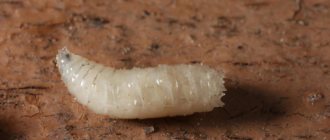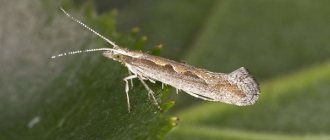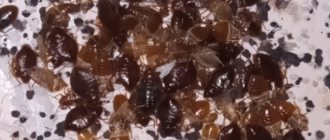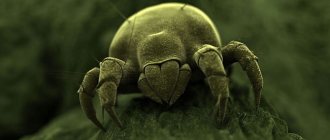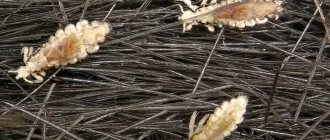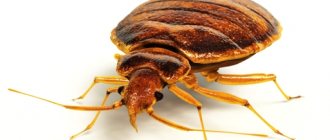Moth is always a problem. But no less problematic is the choice of method to combat it. Many housewives are afraid to use household chemicals to remove moths, not unreasonably fearing for the health of people and pets living in the house. And here the good old folk methods come to the rescue - freezing or scalding. It is enough to take woolen items out into the cold to destroy clothes moths. And in order to remove food moths, boiling water is poured into the jars of cereal in which they have settled.
How effective is cold control?
People found out long ago: moths are afraid of frost. Moreover, if a moth larva dies at -10°C, then for an adult butterfly the fatal frost is only -2°C, since the body of the imago (adult) has a less durable and dense protective shell. But this applies to those cases when the moth is exposed to a sharp temperature change. If an insect is not entirely domestic and senses the approach of cold weather, it hibernates, hiding in foliage, in cracks, in unheated outbuildings, etc. Thus, the moth can also sleep in the attic of the house, waiting for spring and warmer weather. And when the temperature is favorable, it emerges from hibernation to continue its life cycle.
The fact that moths are afraid of the cold was noticed a long time ago - in those days when there was still no central heating and every hut had a stove that was heated. In the same way, other domestic insect pests are afraid of frost, so with the onset of winter, people waited for particularly severe frosts and stopped heating the stove in order to freeze out all the cockroaches and moths with bedbugs. And they themselves went to live with neighbors for two or three days - just to be sure.
These days are not the same, the majority of the population lives in apartment buildings with central heating and it will not be possible to freeze the moth population in one separate apartment. But modern moths have not evolved enough since the days of stove heating to survive in a refrigerator or on a balcony in winter.
By the way, please note: many pawn shops that accept fur coats for storage indicate that they store these outerwear in the refrigerator. Moreover, these refrigerators are not household in power, but industrial, and even moth eggs die at the temperature that is maintained there.
You can guarantee the death of an insect by hanging woolen and other natural wearable items in the cold. If the nature of the fabric allows it to be washed in very hot water, then it is advisable to do this and then dry the clothes at sub-zero ambient temperatures.
It is enough to take clothes with moths out into the cold of -10°C in the morning and bring them back a day later to be sure that the pest is no longer present. At very low temperatures, 10-12 hours will be enough.
Geranium (pelargonium)
In the fight against insects, indoor plants against moths are also useful. The main advantage of geranium is that it blooms all year round. The plant prefers brightly lit window sills. Pelargonium exhibits its fragrant aroma, which pests do not like, after lightly pressing the leaf or stem. Only cut leaves smell just as strong, so they can be laid out on cabinet shelves.
Advice! The aroma quickly disappears from dry geranium leaves, so they need to be replaced with fresh ones.
If you do not have a living plant, use pelargonium essential oil - add it to the water during wet cleaning (25 drops per 1 liter).
Or you can use these tips:
How to use freezing
Things are taken outside or to the balcony, where they are hung in such a way that the fabric stretches out as much as possible. When hung in this way, all the moths that live in the clothes die. If an insect has settled in a fur coat or carpet, you first need to roll things around a little in the snow, and then lightly beat them with a beater (the carpet can be done harder).
While moths in all their forms are dying in the cold, like a coachman in the steppe, you need not to waste precious time and treat cabinets and other spaces. This will allow you to get as close as possible to the complete destruction of the pest. Surfaces are wiped free of dust and wet cleaned.
Insecticide treatments may use a method such as cold fog killing. The fog itself is nothing more than a very finely sprayed chemical that settles on surfaces and kills insects. It can be called cold conditionally, since the sprayed liquid is at room temperature. This method of fighting domestic insects is widely used by companies that come to a call, assess the scale of the disaster and treat the premises using a special evaporator (vaporizer).
Before returning things to their place, it is better to place natural repellents - herbs and spices - there. Dried plants such as:
- peppermint;
- lavender;
- sagebrush;
- tobacco, etc.
For spices, it is better to take black peppercorns, dried ginger, and a cinnamon stick. The required substance is sewn into a gauze or light fabric bag and hung between hangers and laid out on shelves. I don't like moths and the smell of toilet soap.
The effectiveness of freezing can be increased by using this method repeatedly several times at intervals of 3-5 days.
If it's summer outside, small items can be kept in the freezer for a day (hat, scarf, mittens, etc.). Large clothing items cannot be treated in this way, but summer heat and solar ultraviolet radiation are also unpleasant for moths. In the summer sun, wearing well-warmed clothes, a fairly high temperature develops, which has a detrimental effect on laid eggs. And bright sunlight is harmful to adult moths.
The use of folk remedies in the fight against moths
You can fight harmful moths with folk remedies. Their advantages: safe for humans, widely available, easy to use, cheap. Almost all of them are aimed at destroying larvae.
Laundry soap
This is a universal protection against moths at home. Pieces of fresh soap should be placed on the shelves of kitchen furniture, in cabinets, pantries, and closets.
The characteristic unpleasant odor will help not only get rid of adult butterflies, but also limit the movement of caterpillars. The only drawback is that things will smell like laundry soap.
Vinegar and garlic
They are suitable for protecting wool, fur and food products. Apply as follows:
- Dissolve a little vinegar in warm water, and treat the shelves and walls of furniture with the resulting solution.
- Place garlic cloves between stacks of things or near food.
This is a good way to combat larvae. However, it should be noted that the clothes acquire a specific garlic smell.
This remedy for food moths is known to our parents from our grandmothers.
Another option is to heat 2 tbsp in a cup. l. vinegar for 15 minutes, then put in the cupboard for 10 minutes - no less effective.
Orange peels
Adults cannot tolerate the strong aroma of citrus fruits. If fresh orange, lemon, and tangerine skins are placed in a place where clothes and food are stored, butterflies will not lay eggs there. The crusts must be replaced once a month to prevent mold and drying out. Citrus fruits are used only for prophylactic purposes; they have no effect on larvae.
Essential oils
Essential aromatic oils help to repel pests: lavender, fir, rosemary, eucalyptus. They are purchased at the pharmacy. Usage options:
- Drip a little essential liquid into the water and wipe the areas where moths may accumulate.
- Soak napkins in oil and distribute on shelves.
- Spray rooms, closets (everything except clothes, as stains may remain).
- Open bottles of oils and place them next to your laundry.
You can fight moths using a natural and harmless product - essential oil.
Naphthalene
Great-grandmothers and grandmothers used this anti-moth drug. It is available in tablets and briquettes, which are placed in canvas bags and hung in the corners of dressing rooms. The unpleasant, pungent odor has a repellent effect on butterflies and prevents the laying of eggs. It is important to remember that mothballs should not be used in the kitchen. This is dangerous to human health.
If the moth is food
It is more difficult to freeze food products in which food moths live if they are bulk products - cereals, flour, etc. It is very difficult, say, to compactly spread a kilogram of flour in the refrigerator in a layer so thin that they cannot hide from the cold in it. If you place a container or bag, insects can fall into life-saving suspended animation as it gets colder, and the minus will not be so noticeable if there is cereal or flour around.
The feasibility of such treatment is questionable if tiny worms are found in a jar of buckwheat or dried fruit. If they are there, then they are present in the products and their feces. Will you eat this even after freezing?
Therefore, such a product must be processed at high temperatures - steam or boiling water. Boiling water is simpler and more reliable, especially since in most cases we are talking about destroying the moth along with what it is in. Cool boiling water is poured into a jar of flour or other hopelessly spoiled grocery product, which will kill the moth at all stages of its development. For greater persuasiveness, it is better to mix the mass. And after cooling, everything is poured into the toilet or thrown into the trash.
Some cereals, as well as dried fruits, can be washed and dried after scalding, after which they will retain their nutritional value and taste.
Individual grains, as well as legumes, can be calcined in a well-heated frying pan, then packaged in glass jars and stored well sealed.
Tansy
This is the most famous folk remedy for all types of moths. Its specific smell forces the pest to leave its shelter. But since the plant is poisonous, it is not recommended to use it to get rid of food moths.
The flowers are especially toxic. In large quantities they are dangerous even for cattle. In small doses, tansy is used as a medicine for many diseases. Grass grows almost everywhere. Helps get rid of not only moths, but also other household pests.
Tansy reaches its greatest effectiveness during the flowering period. Plants must be dried before being placed in the closet. It is better to do this under a canopy in the fresh air.
For ease of use, flowers are made into unique bouquets. Collect 3-4 branches and tie them tightly into a broom. Hang in dressing rooms, closets and on mezzanines.
To prevent the grass from crumbling, it is placed in gauze bags. The packaging in which shoes are sold is perfect for this purpose, so there is no need to throw it away.
It is not recommended to place too many tansy in one closet. Its smell can provoke a negative reaction from the human respiratory system. Moths, unlike humans, sense even a faint aroma and strive to leave this place as soon as possible.
Dry grass should be renewed periodically. If the moth has already bred and hatched many larvae, tansy is used as an additional remedy. Measures to get rid of the pest must be carried out comprehensively.
Notes
High temperature is also used to process clothing, but only in cases where it will not shrink or become deformed after that. This applies to wool products, especially delicate ones - cashmere, mohair, angora, etc.
Before you take things outside, pay attention to the label. If it says they will fade (fading), turn them right side out. Fabric can fade in both summer and winter bright sun.
A fail-safe method of thermal moth control is placing clothes or items in a dryer or sauna. A few hours are enough for the eggs, larvae, and butterflies to die.
Without prevention, none of the methods can be 100% effective. Therefore, the room needs to be cleaned regularly (wet cleaning plus a vacuum cleaner), and things need to be inspected - both those hanging or lying in the closet, and those that are stored (carpets and fur coats). Repellents are placed in cabinets and in the kitchen, and at the slightest suspicion of the presence of moths, complex treatment is carried out - freezing, insecticides, cleaning.
So, what is the moth afraid of?
Information about what larvae and moths are afraid of is necessary for both an experienced gardener and a housewife. After all, a meeting with this pest is inevitable. These pests do not tolerate overly strong and intense aromas, cold or high temperatures. For extermination, insecticidal and repellent preparations, as well as folk remedies, are used. But before choosing a substance for destruction, you need to familiarize yourself in more detail with what the common moth and its larvae are afraid of. Indeed, with the help of some plants and components a kind of barrier is created.
Varieties of moths
There are more than 200 thousand species of moths. The most common types:
- Furniture moth is yellow-pink in color. It starts in hard-to-reach areas of furniture and multiplies very quickly. In a few days, the female is able to lay 280-300 eggs. Eats furniture upholstery that contains natural fibers, carpets, fur products;
- Wool moths are a pest that is most often found in residential buildings. The moth butterfly is light brown in color without hairs on its head. Most often found in woolen products, museum exhibits, flour and grain products;
- Cabbage moth - mainly affects cruciferous crops. It has a light brown color, with fringe on the lower wings. This species is distributed throughout the world. Harmful to radishes, cabbage, mustard;
- Fungus moth - this type of moth does not live at home. The butterfly is brown in color with white spots. It is found in forests and parks, where it feeds on mushrooms and rotten tree bark;
- Poplar moth - found on poplars when young foliage appears and before the downy period. The moth has a variegated coloration with black dots and fringe on the wings. It often ends up in living spaces along with down, but it is completely safe for humans. Poplar moths often attack fruit trees and garden flowers;
- Wax moth - found in hives and harms bee larvae, and also eats honey and pollen. It is also called bee. A medicinal tincture is made based on wax moth larvae.
Moth larvae
Clothes and food moth butterflies live on average from 3 to 12 days. At this stage they do not feed; their first priority is reproduction. That is, all the damage to food and things in the house is caused by moth larvae.
Clothes moth larvae
- The body of the larva is thin, dirty white, translucent.
- The head is dark, beige-brown, looking like a dark dot at the end of the body.
- In the final stages of growth, the larva can reach 1 centimeter in length.
- They feed mainly in the place where they hatched from the egg, without crawling long distances in search of food.
Food moth larvae
- Food moth larvae can be slightly larger than clothes moth larvae - up to 1.2 centimeters in length.
- The body has a dirty yellow color.
- The head is dark brown.
- They live in the food where they were deposited and cover the space around them with white cobwebs.
When examined with the naked eye, the larvae of both types of moths will look almost identical, so the main thing in the determination can be considered the fact of where exactly you found them.
